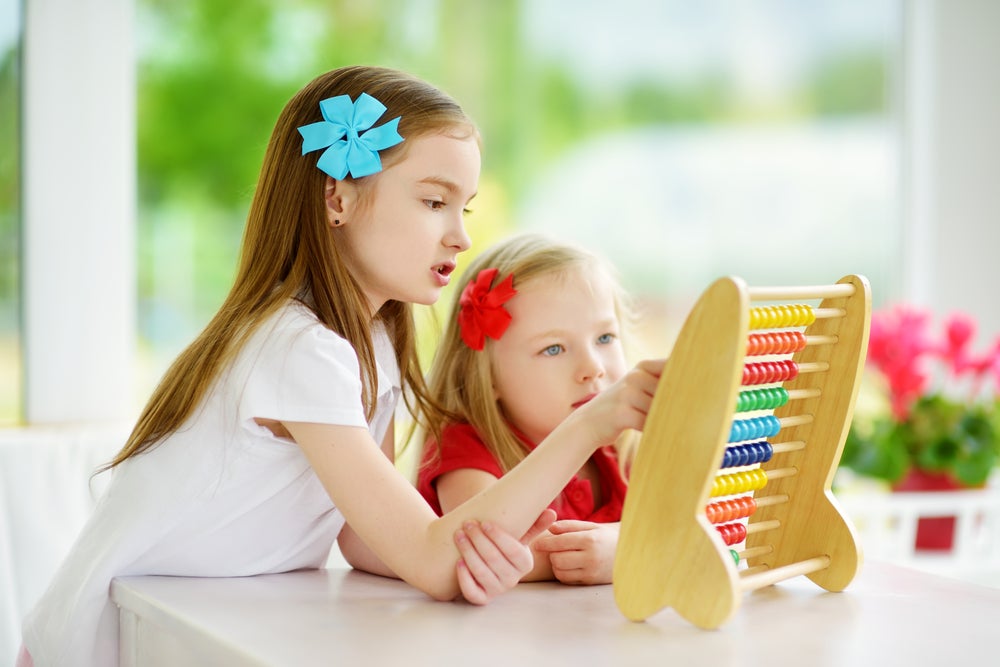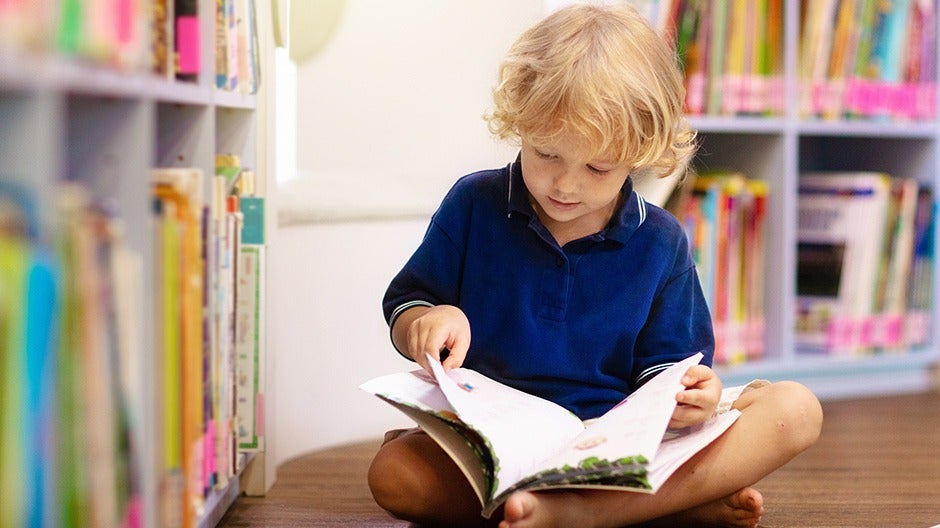Math is one of the most important Core Skills, one of the 5 C’s at the heart of the Begin Approach to helping kids thrive in school and life. Kindergarten math skills are the best predictor of later success in school, but not every kid enjoys the traditional ways of learning math.
Enter: kindergarten math activities! They’re a great way to link learning math to kids’ natural love of play.
Table of Contents
- The Short Cut
- Kindergarten Math Concepts
- 15 Fun Kindergarten Math Activities
- Tips for Helping Kindergarteners with Math
The Short Cut
- Math is an essential Core Skill, and early learners with strong Core Skills do better in school later on
- Essential kindergarten math concepts include counting and cardinality, recognizing numbers beyond 10, adding and subtracting, and recognizing shapes
- Giving positive feedback often and using math in everyday life (“Can you put four apples in our shopping bag?”) can help kindergarteners learn math skills
This article will give you a detailed guideline to help your child get a solid mathematical foundation. These easy at-home activities are fun, engaging, and offer lots of learning opportunities.
Let’s get started!
Kindergarten Math Concepts
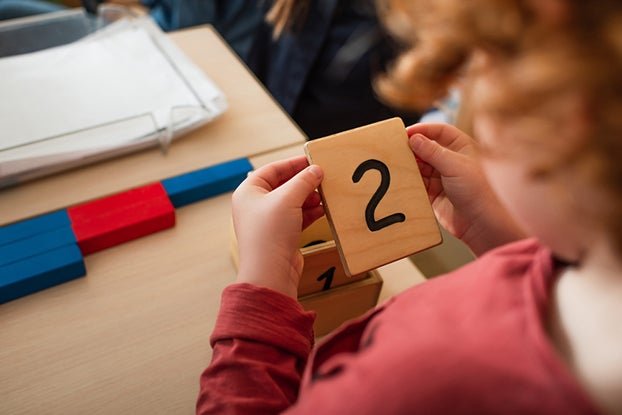
Before diving in, it’s important to understand which concepts your young learner will tackle in kindergarten. That way, it’s easier to know which activities and math skills to focus on at home.
The following are the key math principles your child may know by the end of their kindergarten year.
Counting and Cardinality
One, two, three, four… your child likely already has some early counting skills. They’ll build on their knowledge in kindergarten by learning to count to 100.
They’ll also learn the concept of cardinality, which means understanding that the last number counted represents the total amount in a group. So, if they’re counting goldfish crackers at snack time and the final cracker is 15, they know there are 15 crackers.
Recognizing Numbers Beyond 10
Early math skills teach kids to recognize numbers up to 10. In kindergarten, they’ll practice writing those tricky teen numbers, as well as expand their number recognition to 20 and beyond.
As your child practices counting and recognizing numbers, they’ll start to see the pattern of how numbers progress. And that will help set the foundation for more complex math in later grades.
Adding and Subtracting Single-Digit Numbers
By the end of their kindergarten year, your child may have a basic understanding of addition and subtraction. They’ll start by using manipulatives (like counting cubes or beans) to solve simple problems like 2+3.
Once they can find the solutions in a tangible way, they’ll move on to solving problems using pictures of items and then just the numbers.
Recognizing Shapes and Patterns
Your kindergartener will learn to recognize basic shapes, such as:
- Circle
- Square
- Triangle
- Rectangle
- Rhombus
They’ll learn what makes each shape unique and how to identify them in real-life objects. They’ll also explore patterns. Your child may be asked to create and continue patterns using shapes, colors, numbers, or other objects.
Classifying Objects by Size
While first-grade math emphasizes measuring objects, kindergarten math lays the foundation for this skill by introducing the concept of size. Your child will be asked to compare and classify objects by size, such as big and small, long and short, tall and short.
With the principles above in mind, we’ve compiled a list of activities that will help your child develop these essential skills.
15 Fun Kindergarten Math Activities
1) Shape Hunt
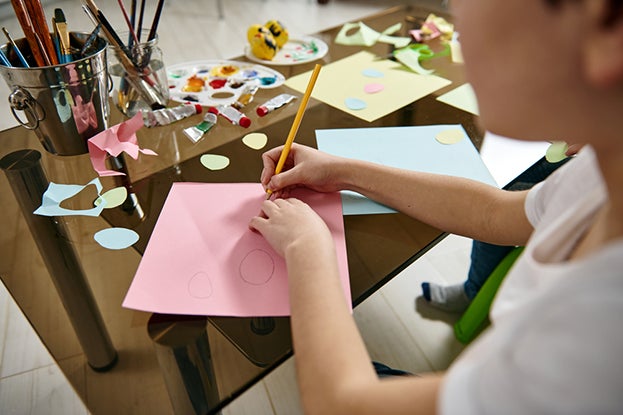
What You’ll Need:
- Notebook
- Crayons
What to Do:
Start by selecting any two objects around your house that look different but have the same shape. Then give your child clues about one of the objects. For example, you might say, “It has a round shape.”
Your child will need to act as a detective and solve this shape mystery! When they are confident that they know what this object is, encourage them to take their detective notebook and draw the item.
Repeat this process for the second object.
Once your little detective has found and drawn the two objects, you can evaluate them and discuss other items with the same shape. So, for something that’s round, this can be plates, pizza, door handles, and so on.
Once you’re confident they understand the properties of the shape, you can play the game again with another shape (triangle, square, etc.).
You don’t have to limit yourselves to your indoor space. You can also head outside and search for many interesting shapes in your garden, local park, or neighborhood if you’d like.
Find out more about this interesting game here.
2) Count the Beans
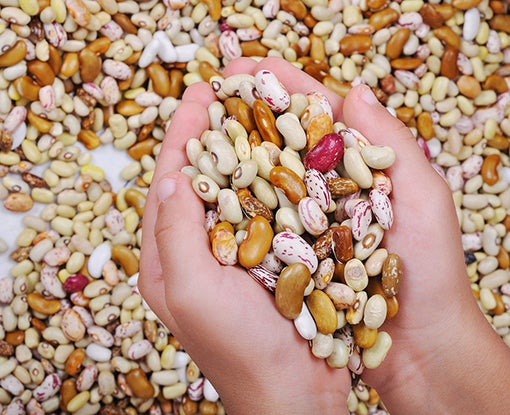
What You’ll Need:
- Spoon
- Dried kidney beans
What to Do:
For this fun activity, you will need to take a spoon and hold it outstretched. Your child will then proceed to put one dried kidney bean at a time onto the spoon.
When the first one falls off, you then count how many beans you managed to get on the spoon.
You can play this game with a larger spoon as well. For this, the numbers will get higher, so your child will need to be familiar with higher numbers before they’re ready for this one.
To help, a simple 10 frame should do the trick (a 10 frame is basically a rectangle with 10 equal spaces (five on top and five on the bottom).
If, when counting the beans, you end up with more than 10, you can put each set of 10 in a small paper cup, allocate the cups to each frame, and then add everything for the final tally.
This activity helps kindergarteners continue practicing their counting and gain an understanding of number sense.
3) Building Sets with BlocksBlocks
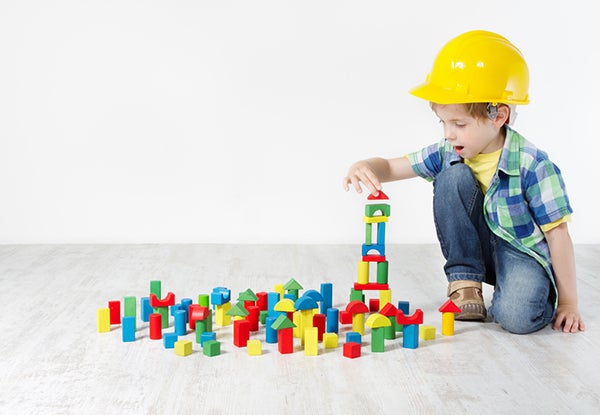
What You’ll Need:
- Building blocks
What to Do:
This activity requires you to ask your young learner to build a color tower with a specific number of blocks. For example, “Build a blue tower with 10 blocks, a red tower with eight blocks, and a yellow tower with 11 blocks.”
All this information will need to be remembered by your child, so this can be a great way to help build memory. Children will also continue practicing colors and counting skills with this activity.
4) Number Guessing
What You’ll Need:
- Magnetic numbers (0 – 9)
What to Do:
For this activity, your child will need to put their hands behind their back. You will then place one of the magnetic numbers in their hands for them to feel. Can they guess the number?
If this is a little challenging at first, it can help to have another set of magnetic numbers that they can see as they feel.
This is a great sensory activity that can help familiarize children with each number’s interesting shape and unique qualities.
5) Shape Hopscotch
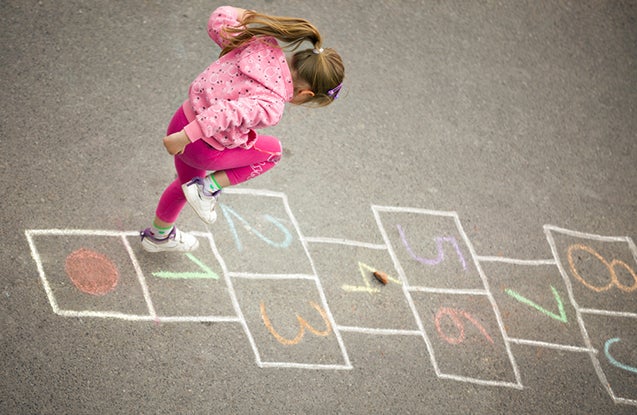
What You’ll Need:
- Different colored paper
- Scissors
- Painter’s tape
What to Do:
Hopscotch is one of our favorite games here at Begin. If you’re looking to play the traditional way, you can check out these number games, which include fun math-related activities in addition to Hopscotch.
For this article, we decided to switch things up a bit with shape hopscotch. All you need to do is cut out six different (but easily recognizable) shapes and give each shape its own color (for example, red circles, yellow triangles, blue squares, purple stars, etc.).
Once you have your shapes, tape them to the floor with painter’s tape. While taping, ensure that the spacing works for your child (the shapes aren’t too far apart).
You can encourage your child to jump, hop, or wiggle through the shapes. Here are a few ways they can make it through their shape maze:
- Call out colors or shapes for your child to race and find
- Have them hop from one side to the other side by only touching one shape or color
- Give them directions as they go, and ask what they’ve landed on. For example, “Jump three shapes to the left, one shape up, and two shapes right. What color and shape are you on?”
This is an excellent and fun way for kids to continue working on their gross motor skills while incorporating shape and color recognition. Children will also work on the important skill of following directions.
6) Make a Number Line
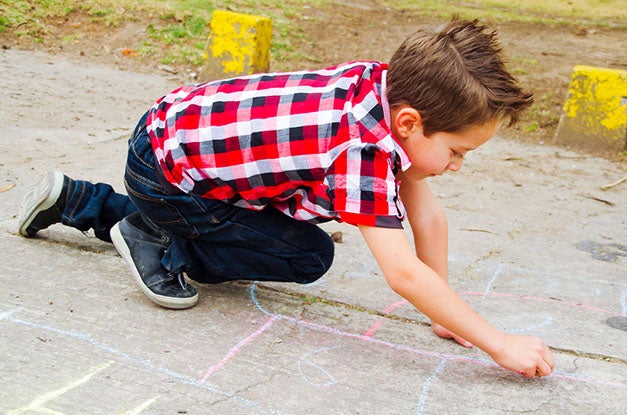
What You’ll Need:
- Chalk
- Paved area outside
- Deck of cards
What to Do:
On your paved area outside, draw a large number line with chalk. You can write numbers up to 10, 20, or even 30 as your child becomes familiar with those numbers.
Next, take five red playing cards (numbers 1 – 5) and five black playing cards (numbers 1 – 5). Then you each get a token which you’ll place in the middle of the number line. Mix the cards and put them face down.
Next, take turns picking cards. A red card means you go up the number line based on the card’s value (for example, if you pull a red five of hearts, you move up five spaces). A black card, on the other hand, means you go down on the number line (red four of clubs = down four spaces).
If you end up below the number one or above the top number on the line, you’ll stay put until all players have had their turn.
After each player has picked four cards, whoever is highest on the number line wins!
7) Snowball Battle
What You’ll Need:
- Paper
- 3 small buckets
What to Do:
Crumble your paper to make “snowballs.” Next, place your buckets at the end of the room. Challenge your child to toss the snowballs into any of the buckets until they reach a target number (e.g., 10).
If you have multiple kids, this can turn into some friendly competition with a timer. How many can you land in five minutes?
You can also vary the game a bit for older kids by having them toss all 10 snowballs into the three buckets and then write down how they got to 10 (for example, with 3 balls in one bucket, 4 balls in the next, and 3 balls in the last). How many ways can it be done?
Gross motor and counting skills come into play when engaging in this activity.
8) Comparing Objects
What You’ll Need:
- A variety of your child’s toys
What to Do:
Ask your child to gather some of their favorite stuffed animals or other toys and put them in a pile. Reach in and randomly grab two.
Hold them up, and ask your child which one is shorter. They may be able to compare the two visually, but if they don’t, help them line them up to compare.
Repeat the process with different objects in the pile, asking them to compare based on size. Finally, challenge your child to line up all the toys from their pile from shortest to tallest.
Comparing objects helps reinforce basic measurement concepts and encourages critical thinking and problem-solving skills.
9) Simon Says: Count
What You’ll Need
- An open space for playing in
What to Do:
This classic game is a great way to practice counting in a fun and interactive way. Have your child stand nearby and listen for commands that start with, “Simon says.” If they hear that phrase, they do the action. If they don’t, they stay still.
Keep the commands simple for this version of the game and incorporate counting into them. Use these suggestions to get the game started:
- Touch your nose three times
- Hop five times
- Clap your hands two times
- Count to ten while standing on one foot
Take turns being Simon, and encourage your child to come up with their own commands.
This game will help them practice counting, listening, and following instructions. Plus, it’s an excellent way to burn off energy while learning!
10) Playdough Counting
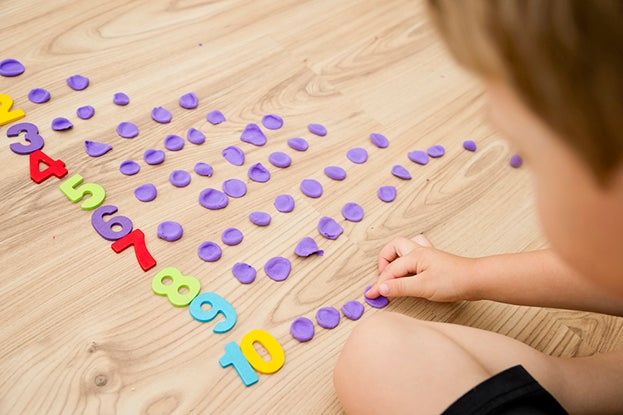
What You’ll Need:
- Magnetic numbers (1-10)
- A container of playdough
What to Do:
Set out the magnetic numbers in a vertical line, with 1 at the top and 10 at the bottom. Ask your child to roll a small ball of playdough and place it next to the 1. Then have them flatten it into a disc shape.
Encourage them to put two playdough discs next to the number 2. Then see if they can continue counting and placing the correct number of discs next to the rest of the magnetic numbers.
If your child finds this activity too easy, here are some fun ways to make it more challenging:
- Create a unique shape for each number
- Build the numbers out of playdough instead of using the magnets
- Ask them to count how many playdough discs they made in all
- Use different colors of playdough for each number
Manipulating the playdough will help your child build their fine motor skills as they practice counting.
11) Pom Pom Toss
What You’ll Need:
- 5 small, fuzzy pom poms
- A plastic shoebox (or any similarly-sized container)
- Paper and pencil
What to Do:
Set the container on the table and have your child step a few feet back. Hand them a pom pom and ask them to try to throw it into the container. Repeat for the remaining pom poms.
Have your child count how many pom poms are in the container. Then ask them how many didn’t make it in.
Use those numbers to write an addition number sentence on the paper. For example, if they got three pom poms in the container, two were outside. With those numbers, you’d write: 2 + 3 = 5
Ask them to try again. Write a number sentence for this attempt. Here are all the possibilities:
- 0 + 5 = 5
- 1 + 4 = 5
- 2 + 3 = 5
- 3 + 2 = 5
- 4 + 1 = 5
- 5 + 0 = 5
This game helps your child practice adding to 5. It also helps them see how many ways they can make 5 using two numbers.
12) Practice Math with HOMER
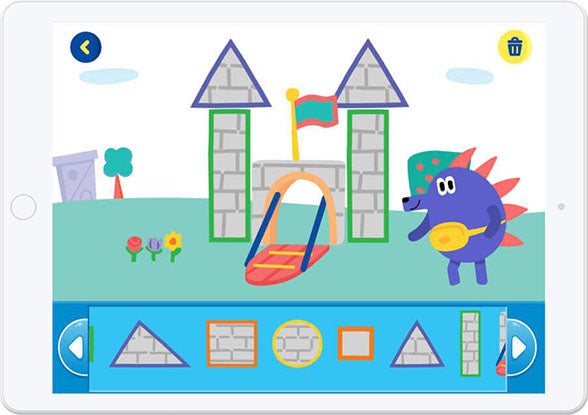
What You’ll Need:
- A subscription to the HOMER app by Begin
What to Do:
Help your child build math confidence with the HOMER app by Begin. In just 15 minutes a day, your child can explore kindergarten math concepts through games, stories, and songs.
It’s personalized for their learning level and interests, so they’ll stay engaged and motivated. Plus, HOMER is designed by learning experts and aligned with curriculum standards to ensure your child develops essential math skills.
With HOMER, they can practice counting, addition, subtraction, shapes, and more! They’ll have fun while building the skills they need to succeed.
13) What Comes Next?
What You’ll Need:
- Paper
- Markers or crayons
What to Do:
Draw a simple pattern using shapes on the paper. You could try triangle, circle, triangle, circle or square, oval, square, oval.
Ask your child to continue the pattern by drawing the next shape. Have them explain why they drew the shape they did.
Have your child draw a pattern for you to continue. Share your reasoning behind why you drew the shape you did.
To mix this game up, try all sorts of patterns. You can use colors, shapes, numbers, and letters to create various patterns. If your child has mastered simple A,B patterns, make it harder by trying some like this:
- AAB (circle, circle, square)
- AABB (circle, circle, square, square)
- ABC (circle, triangle, heart)
By making pattern play fun, you’re helping your child develop their logical thinking and problem-solving skills.
14) Sensory Shapes
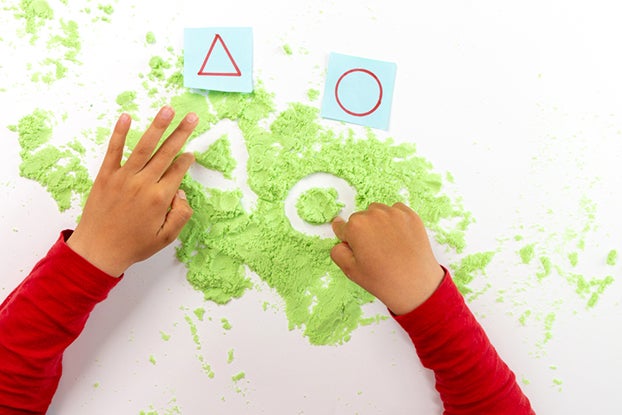
What You’ll Need:
- Sand, salt, or shaving cream
- A tray
- Sticky notes
- A marker
What to Do:
With the marker, draw a simple shape on each sticky note. Place the sticky notes on the table above the tray.
Spread sand, salt, or shaving cream evenly across the tray. The material should be thick enough that your child can use their finger and draw in it, leaving a clear imprint.
Ask your child to pick a shape to draw. Have them use their pointer finger to draw it in the sensory material. Then ask them to name the shape.
Next, have your child draw the same shape again with their eyes closed. This makes the activity more challenging and requires them to rely on their sense of touch.
Repeat these steps with each of the shapes. Finally, ask your child to combine shapes to create a picture in the tray.
This simple sensory activity helps reinforce basic geometric concepts and builds fine motor skills.
15) Penny Hand
What You’ll Need:
- A pen
- A piece of paper
- Several pennies
What to Do:
How many pennies can fit on your child’s hand? Ask them to guess how many they think. Then help them find the answer with this simple kindergarten math activity.
Start by tracing your child’s hand on the paper. Encourage them to stay still during this part so you get an accurate representation of their hand.
Next, show them how to place pennies on the hand. Challenge them to create rows of pennies that fit as perfectly as possible.
When their entire hand is covered, have them count the pennies. Was it more or less than they originally thought? Then ask if they think more or less pennies would fit on your hand. Trace it, and let them discover the answer.
This activity is a good way to introduce estimation. It also helps students practice counting and allows them to compare sizes.
Tips for Helping Kindergarteners with Math

The above activities should help your child practice and understand their math skills. Additionally, here are a few key points to keep in mind.
Incorporate Math into Everyday Life
Math is all around us! It is in the shapes of objects and buildings, the measurements we take when baking, and the sorting of patterns. This makes it easy to incorporate math into everyday activities.
Remember that the more practice your child gets, the easier it will be to grasp these foundational concepts.
Keep Practice Sessions Short
Kindergarteners have short attention spans, so keep your practice sessions short. It’s OK to work for five or 10 minutes at a time and then move on to something different.
Make It Enjoyable
When something seems too challenging, kids can quickly become overwhelmed and give up before starting. Help your child understand how fun math is by regularly introducing them to math activities in a fun, relaxed way.
Practice Positive Reinforcement
Positive feedback is one of the key components for your child to continue having a healthy relationship with mathematics. So, when they finally grasp a concept they’ve been struggling with, make a big deal out of it!
And, if there’s a math skill they haven’t grasped yet, be patient and continue practicing. Soon enough, they’ll get it!
Kindergarten Math Activities with Begin
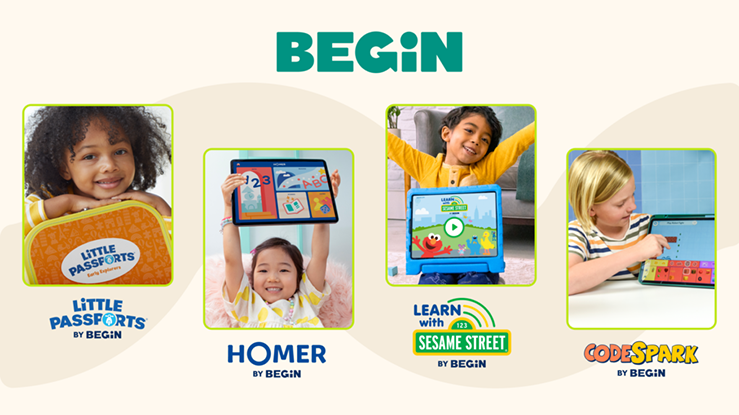
Sometimes kids (and adults) view math negatively. You’ll often hear them express how challenging it is. But kindergarten math activities can help build positivity and confidence!
While it can be a challenge, math is still one of the most important subjects children learn and can benefit them for the rest of their lives.
Begin can help. Our HOMER app is filled with fun math activities for kindergartners, or they can use codeSpark to explore math concepts while learning to program their own video games (reading-free!).
Our age- and stage-matched learning membership also helps kids learn the skills that matter most for their age, including math.
Take our online quiz today to see how we can help your family!
